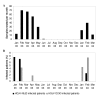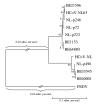A novel pancoronavirus RT-PCR assay: frequent detection of human coronavirus NL63 in children hospitalized with respiratory tract infections in Belgium - PubMed (original) (raw)
A novel pancoronavirus RT-PCR assay: frequent detection of human coronavirus NL63 in children hospitalized with respiratory tract infections in Belgium
Elien Moës et al. BMC Infect Dis. 2005.
Abstract
Background: Four human coronaviruses are currently known to infect the respiratory tract: human coronaviruses OC43 (HCoV-OC43) and 229E (HCoV-229E), SARS associated coronavirus (SARS-CoV) and the recently identified human coronavirus NL63 (HCoV-NL63). In this study we explored the incidence of HCoV-NL63 infection in children diagnosed with respiratory tract infections in Belgium.
Methods: Samples from children hospitalized with respiratory diseases during the winter seasons of 2003 and 2004 were evaluated for the presence of HCoV-NL63 using a optimized pancoronavirus RT-PCR assay.
Results: Seven HCoV-NL63 positive samples were identified, six were collected during January/February 2003 and one at the end of February 2004.
Conclusions: Our results support the notation that HCoV-NL63 can cause serious respiratory symptoms in children. Sequence analysis of the S gene showed that our isolates could be classified into two subtypes corresponding to the two prototype HCoV-NL63 sequences isolated in The Netherlands in 1988 and 2003, indicating that these two subtypes may currently be cocirculating.
Figures
Figure 1
Detection of HCoV-NL63 and HCoV-OC43 in samples from patients suffering from severe respiratory symptoms. (A) Number of samples tested per month. (B) Patients infected with HCoV-NL63 and HCoV-OC43. A single HCoV-229E positive sample was isolated in April 2003 (not shown).
Figure 2
Selection of primers for the novel pancoronavirus RT-PCR. Shown is the alignment of 14 coronaviral sequences of a conserved region of the polymerase gene. The forward (Cor-FW) and reverse (Cor-RV) primer sequences are shown at the bottom (Y = C/T, W = A/T, V = A/C/G, R = A/G, H = A/T/C, N = A/C/T/G). The coordinates of Cor-FW and Cor-RV are 14017 and 14248, respectively, in the HCoV-NL63 complete genome sequence. The 14 coronavirus sequences used here are available from GenBank under the following accession numbers: HCoV-NL63, AY567487; HCoV-229E, AF304460; infectious bronchitis virus (IBV), Z30541; SARS-CoV, AY313906; HCoV-OC43, AY391777; PEDV, AF353511; bovine coronavirus (BCoV), AF391541; transmissible gastroenteritis virus, AF304460; MHV, X51939; PHEV, AF124988; sialodacryoadenitis virus (SDAV), AF124990; turkey coronavirus (TCoV), AF124991; canine respiratory coronavirus (CRCV), AY150273; feline infectious peritonitis virus (FIPV), AF124987.
Figure 3
Gel electrophoresis after pancoronavirus RT-PCR assay. The indicated band of 251 bp corresponds with the expected amplicon size. As a marker Molecular Weight Marker VI was used (Boehringer Mannheim, Germany).
Figure 4
Phylogenetic analysis of the partial ORF1a nucleotide sequences. Accession numbers: HCoV-NL63, AY567487; HCoV-NL, AY518894; HCoV-229E, AF304460; NL-p466, AY567488; NL-p246, AY567489; NL-p251, AY567490; NL-p496, AY567491; NL-p223; AY567492; NL-p248, AY567493; NL-p72, AY567494; CAN39, AY675541; CAN52, AY675542; CAN57, AY675543; CAN140, AY675544; CAN146, AY675545; CAN214, AY675546; CAN449, AY675547; CAN470, AY675548; CAN483, AY675549; CAN495, AY675550; CAN528, AY675551; CAN531, AY675552; CAN543, AY675553.
Figure 5
Phylogenetic analysis of the partial S gene nucleotide sequences based on an alignment of the Belgian spike sequences, spike sequences from the positive samples identified in The Netherlands, and the prototype HCoV-NL63 sequences available in GenBank. Accession numbers: HCoV-NL63, AY567487; HCoV-NL, AY518894. PEDV was used as an outgroup.
Similar articles
- Coronavirus HKU1 and other coronavirus infections in Hong Kong.
Lau SK, Woo PC, Yip CC, Tse H, Tsoi HW, Cheng VC, Lee P, Tang BS, Cheung CH, Lee RA, So LY, Lau YL, Chan KH, Yuen KY. Lau SK, et al. J Clin Microbiol. 2006 Jun;44(6):2063-71. doi: 10.1128/JCM.02614-05. J Clin Microbiol. 2006. PMID: 16757599 Free PMC article. - Human coronavirus NL63, France.
Vabret A, Mourez T, Dina J, van der Hoek L, Gouarin S, Petitjean J, Brouard J, Freymuth F. Vabret A, et al. Emerg Infect Dis. 2005 Aug;11(8):1225-9. doi: 10.3201/eid1108.050110. Emerg Infect Dis. 2005. PMID: 16102311 Free PMC article. - Coronavirus causes lower respiratory tract infections less frequently than RSV in hospitalized Norwegian children.
Kristoffersen AW, Nordbø SA, Rognlien AG, Christensen A, Døllner H. Kristoffersen AW, et al. Pediatr Infect Dis J. 2011 Apr;30(4):279-83. doi: 10.1097/INF.0b013e3181fcb159. Pediatr Infect Dis J. 2011. PMID: 21057374 - The widening scope of coronaviruses.
Kahn JS. Kahn JS. Curr Opin Pediatr. 2006 Feb;18(1):42-7. doi: 10.1097/01.mop.0000192520.48411.fa. Curr Opin Pediatr. 2006. PMID: 16470161 Review. - Identification of new human coronaviruses.
Pyrc K, Berkhout B, van der Hoek L. Pyrc K, et al. Expert Rev Anti Infect Ther. 2007 Apr;5(2):245-53. doi: 10.1586/14787210.5.2.245. Expert Rev Anti Infect Ther. 2007. PMID: 17402839 Review.
Cited by
- Sensitive and Accurate Quantification of Enterovirus-D68 (EV-D68) Viral Loads Using Droplet Digital PCR (ddPCR).
Grizer CS, Li Z, Mattapallil JJ. Grizer CS, et al. Microorganisms. 2024 Jul 23;12(8):1502. doi: 10.3390/microorganisms12081502. Microorganisms. 2024. PMID: 39203345 Free PMC article. - Co-Circulation of Multiple Coronavirus Genera and Subgenera during an Epizootic of Lethal Respiratory Disease in Newborn Alpacas (Vicugna pacos) in Peru: First Report of Bat-like Coronaviruses in Alpacas.
Llanco L, Retamozo K, Oviedo N, Manchego A, Lázaro C, Navarro-Mamani DA, Santos N, Rojas M. Llanco L, et al. Animals (Basel). 2023 Sep 21;13(18):2983. doi: 10.3390/ani13182983. Animals (Basel). 2023. PMID: 37760383 Free PMC article. - Molecular mechanisms of human coronavirus NL63 infection and replication.
Castillo G, Mora-Díaz JC, Breuer M, Singh P, Nelli RK, Giménez-Lirola LG. Castillo G, et al. Virus Res. 2023 Apr 2;327:199078. doi: 10.1016/j.virusres.2023.199078. Epub 2023 Feb 22. Virus Res. 2023. PMID: 36813239 Free PMC article. Review. - Epidemiology of Non-SARS-CoV2 Human Coronaviruses (HCoVs) in People Presenting with Influenza-like Illness (ILI) or Severe Acute Respiratory Infections (SARI) in Senegal from 2012 to 2020.
Faye MN, Barry MA, Jallow MM, Wade SF, Mendy MP, Sy S, Fall A, Kiori DE, Ndiaye NK, Goudiaby D, Diamanka A, Niang MN, Dia N. Faye MN, et al. Viruses. 2022 Dec 21;15(1):20. doi: 10.3390/v15010020. Viruses. 2022. PMID: 36680061 Free PMC article. - Human coronaviruses: Origin, host and receptor.
Tang G, Liu Z, Chen D. Tang G, et al. J Clin Virol. 2022 Oct;155:105246. doi: 10.1016/j.jcv.2022.105246. Epub 2022 Jul 21. J Clin Virol. 2022. PMID: 35930858 Free PMC article. Review.
References
- Cavanagh D. Nidovirales: a new order comprising Coronaviridae and Arteriviridae. Arch Virol. 1997;142:629–633. - PubMed
- Lai MMC, Holmes KV. Coronaviridae: the viruses and their replication. In: Knipe DM, Howley PM, editor. Fields Virology. 4. Lippincott Williams & Wilkins; Philadelphia; 2001. pp. 1163–1185.
- Hamre D, Procknow JJ. A new virus isolated from the human respiratory tract. Proc Soc Exp Biol Med. 1966;121:190–193. - PubMed
Publication types
MeSH terms
Substances
LinkOut - more resources
Full Text Sources
Other Literature Sources
Miscellaneous




